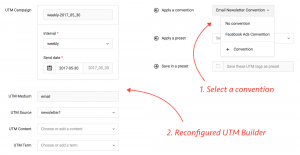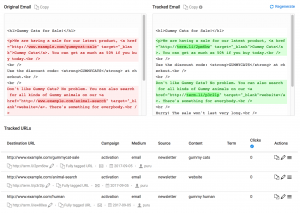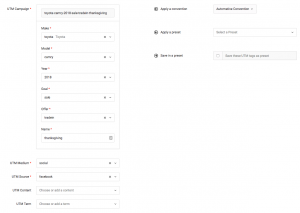Great tips! I also highly recommend you use Campaign URLs/UTM tags for the links in your CRM's automated emails. Many CRMs tell you if someone opened an email but not much more. With tags in those emails, you now have wonderful insight into which of your templates are sending engaged traffic back to your website and which ones are duds. Get those visits out of GA's Referral bucket and into Email where they belong. It WILL make you rethink your templates and follow-up processes. Make changes and test!
You are using an out of date browser. It may not display this or other websites correctly.
You should upgrade or use an alternative browser.
You should upgrade or use an alternative browser.
Guide for UTM-tagging URLs
- Thread starter George Nenni
- Start date
If you create a lot of UTM tracking URLs, you might want to look at Terminus. It not only helps you manage all UTMs in one place, you can also create complex UTM naming conventions and add tracking to emails quickly.
You can customize URL builder based on your UTM conventions:

If you are looking for some inspiration you can look at an article about how to come up with UTM naming conventions.
It's also possible to add UTM tracking to all the URLs in an email in a couple of clicks:

Disclosure: I apologize in advance if this comes off as too self promotional. I'm the founder of Terminus. I also used UTM tracked URLs created using Terminus in this post.
You can customize URL builder based on your UTM conventions:

If you are looking for some inspiration you can look at an article about how to come up with UTM naming conventions.
It's also possible to add UTM tracking to all the URLs in an email in a couple of clicks:

Disclosure: I apologize in advance if this comes off as too self promotional. I'm the founder of Terminus. I also used UTM tracked URLs created using Terminus in this post.
If you create a lot of UTM tracking URLs, you might want to look at Terminus. It not only helps you manage all UTMs in one place, you can also create complex UTM naming conventions and add tracking to emails quickly.
...
Disclosure: I apologize in advance if this comes off as too self promotional. I'm the founder of Terminus. I also used UTM tracked URLs created using Terminus in this post.
Not sure you can put an advance apology in a disclosure at the end
- Feb 11, 2015
- 2,492
- 765
- First Name
- Alex
Eh... Standards according to whom? Him...? Those have been hijacked from other verticals.Not sure you can put an advance apology in a disclosure at the endStill, cool stuff. Thanks for sharing. Have you looked at the "automotive standard" UTM tracking guide that PCG put out? What problems does Terminus (or other similar products) solve that that guide doesn't?
Not sure you can put an advance apology in a disclosure at the endStill, cool stuff. Thanks for sharing. Have you looked at the "automotive standard" UTM tracking guide that PCG put out? What problems does Terminus (or other similar products) solve that that guide doesn't?
That's fair. I started typing it in the beginning of the post, but then moved it to the bottom without changing the text.
I haven't looked at the UTM guide about automative standard, but would be interested if you have a link. Having said that, Terminus is mostly a software tool that helps with building and managing UTM tracking URLs. It's meant to be a replacement for simple URL builders like Google or spreadsheets.
Eh... Standards according to whom? Him...? Those have been hijacked from other verticals.
Your clear opinion of the source of my reference is duly noted. I put those words in quotations to make it clear those weren't my words, but someone else's. I'm not saying it is THE standard. But since you posed the question, I'll answer: According to me, it's my standard. At least right now, today, until I find something better. That's why I'm observing and participating in this conversation.
To your "hijacked" claim: meh. Look, most white papers delivered in our space contain content from other sources, auto and otherwise. In particular, this UTM guide pulled together good information in a simple presentation that I, and many of my dealer friends and vendor partners, have been able to use to fine tune the results reported to us in GA. For me, it's been useful. It's updated regularly and it's free. If all of our referral providers would use it, we'd have better reporting from our analytics. Thus, the precise reason I asked the two questions of the fine gentleman from Terminus. I'm just looking for simpler, faster, and/or better ways to do things.
That's fair. I started typing it in the beginning of the post, but then moved it to the bottom without changing the text.
I haven't looked at the UTM guide about automative standard, but would be interested if you have a link. Having said that, Terminus is mostly a software tool that helps with building and managing UTM tracking URLs. It's meant to be a replacement for simple URL builders like Google or spreadsheets.
The problem for me has come when vendors get a little creative with all of the tag fields available. They don't seem to understand that this reporting isn't for them, it's for the site owner (me.) When they do things that kick their traffic into buckets we're not watching, it's bad for them and us. For instance, if their traffic ends up in the referral bucket because of capitalization or weird source/mediums, it creates extra work for us to decipher. So MY standard is this one: http://www.pcgresearch.com/google-utm-guide/ It works for me, today anyway.
I do think that having precise UTM guidelines for each vertical is useful for people in those verticals. As a vendor of UTM tracking software, I myself find it difficult to talk in generic terms to my customers who come from different verticals. So having specific recommendations definitely help.
I just downloaded the UTM guideline report. I agree with a lot of guidelines in the report, e.g. use lowercase, no spaces, etc. In fact, Terminus helps enforce these things.
Based on some automative data from the guide, I created a sample convention for UTM campaign name . The campaign names generated from this should be easily searchable in Google Analytics using filters.

It's also difficult to define exactly what goes in UTM Campaign vs UTM Content. My general guideline is to keep copy related stuff (CTA, position information, banner sizes, etc.) in UTM content and everything else in UTM campaign.
I just downloaded the UTM guideline report. I agree with a lot of guidelines in the report, e.g. use lowercase, no spaces, etc. In fact, Terminus helps enforce these things.
Based on some automative data from the guide, I created a sample convention for UTM campaign name . The campaign names generated from this should be easily searchable in Google Analytics using filters.

It's also difficult to define exactly what goes in UTM Campaign vs UTM Content. My general guideline is to keep copy related stuff (CTA, position information, banner sizes, etc.) in UTM content and everything else in UTM campaign.
- Feb 11, 2015
- 2,492
- 765
- First Name
- Alex
"This research report summarizes Google’s recommendation for labeling website traffic as well as our suggestions for improving the dealer’s marketing analysis. When dealers properly label traffic sources, using UTM tags, they can more quickly inspect campaign conversions, engagement, and outcomes in Google Analytics and VistaDash."The problem for me has come when vendors get a little creative with all of the tag fields available. They don't seem to understand that this reporting isn't for them, it's for the site owner (me.) When they do things that kick their traffic into buckets we're not watching, it's bad for them and us. For instance, if their traffic ends up in the referral bucket because of capitalization or weird source/mediums, it creates extra work for us to decipher. So MY standard is this one: http://www.pcgresearch.com/google-utm-guide/ It works for me, today anyway.
No offense, but they created those so their dealer clients' collateral performance jives (measures well) with their software (ROI-BOT, now VistaDash). Their group was probably sick and tired of having to hold the hand of dealerships, so it makes it easier on them, which equates to higher retention / less attrition and more dollars. They'll not do anything without a strategy and dollars in mind. Much like any attribution company hates the fact that dealer tags are incorrectly used, just across the board. When the results cannot be calculated easily and scaled it makes their reports look like shit. Granted and to your point, you might have gotten something out of it. For those variables that can be subjectively or creatively named, well that's up to you to understand what your data represents.
Who the heck was on the board for this so-called "standardization?"
--------------
Stuff like this will also cause those tools to have MAJOR headaches.
A complete user touch point recovery across competing vendors that tend to avoid supporting each other is not the only challenge for advertisers. Google is not alone in its decision to exclude cookie IDs in downloadable files in the name of privacy: Other advertising powerhouses, such as Amazon, Facebook and Twitter, don’t share any of their identifiers either.
Hence, it is fair to say that clients that leverage several of the leading online platforms will always have some key touch point data missing in their attribution models. Not exactly holistic, is it?

Those guidelines are really basic. OK, we can presume that your average internal dealer representative doesn't have a lot of digital knowledge. Based upon that, the guideline is a good one, because shit gets named wacky. However, I HEAVILY question the entire standardization protocol mixed in with the marketing / promotion of a proprietary tool. That is all.I just downloaded the UTM guideline report. I agree with a lot of guidelines in the report, e.g. use lowercase, no spaces, etc. In fact, Terminus helps enforce these things.
Last edited:
Ok, so I understand your philosophical issues with using this document. That opinion is clear and recognized here. For the sake of clarity, let’s even stipulate that your opinion is the only valid one in this conversation. Help me understand why I can’t/shouldn’t use this doc. Is it only because of who and how it was collected? Is there some inaccuracy or bad direction in there? If all dealers and all referring vendors were using this as a standard, at least as a framework, where does it create problems?"This research report summarizes Google’s recommendation for labeling website traffic as well as our suggestions for improving the dealer’s marketing analysis. When dealers properly label traffic sources, using UTM tags, they can more quickly inspect campaign conversions, engagement, and outcomes in Google Analytics and VistaDash."
No offense, but they created those so their dealer clients' collateral performance jives (measures well) with their software (ROI-BOT, now VistaDash). Their group was probably sick and tired of having to hold the hand of dealerships, so it makes it easier on them, which equates to higher retention / less attrition and more dollars. They'll not do anything without a strategy and dollars in mind. Much like any attribution company hates the fact that dealer tags are incorrectly used, just across the board. When the results cannot be calculated easily and scaled it makes their reports look like shit.
Who the heck was on the board for this so-called "standardization?"
--------------
This is also going to cause those tools to have MAJOR headaches.
A complete user touch point recovery across competing vendors that tend to avoid supporting each other is not the only challenge for advertisers. Google is not alone in its decision to exclude cookie IDs in downloadable files in the name of privacy: Other advertising powerhouses, such as Amazon, Facebook and Twitter, don’t share any of their identifiers either.
Hence, it is fair to say that clients that leverage several of the leading online platforms will always have some key touch point data missing in their attribution models. Not exactly holistic, is it?








